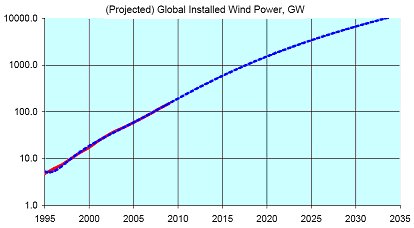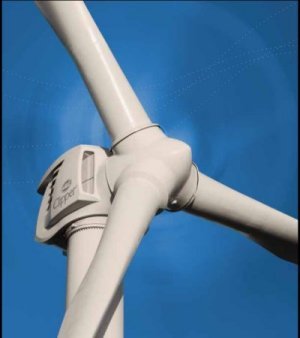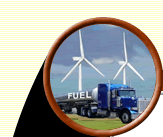 |
Updated
12/20/2010
WindFuels
Scale-up
The two most common
problems with most of the renewable energy ideas is either
they are not competitive or they are not scalable to the multi-terawatt
level. We don't just need an alternative solution that can
competitively produce a million gallons/year, but rather one
that can ramp-up to
tens of millions of barrels/day. Industrial ramp-up rates greater
than 20% annually are never easy to sustain more than a decade.
However, we’ve seen industrially driven scale-ups in
the past of greater magnitude than what is needed here, and
it can be instructive to reflect on some of the amazing past
successes – the automotive, aircraft, petrochemical,
television, computer, cell-phone, wind power, and drug industries,
to name but a few. Common denominators in the successes are
profitability within a reasonable time frame, constantly escalating
demand, and ample raw materials that can be easily exploited
and meet a continuously escalating demand.
In the Economics Overview,
we’ve shown that
WindFuels would be very profitable
in
a
short
time
frame.
One of the most important reasons for this is that there is a growing supply
of very cheap off-peak energy in regions of high wind penetration. As we show
on the Off-peak Wind page, and in a recent
article on Deployment, Off-peak
Wind energy will continue to be an
order of magnitude cheaper than CSP and most other renewable resources. Most
of the equipment needed for Windfuels is very similar to that which has been
used
in
the petrochemical industry for the past 60 years or more. It is cheap compared
to
what is needed
for algae oil or cellulosic ethanol because it doesn’t involve complex
cellular extractions.
As traditional crude production gradually diminishes
and must be replaced by more expensive and polluting fossil alternatives, there
is an assured demand
for scale up for WindFuels. We therefore need to assess
the feedstocks, then we’ll look briefly at the challenges which would be
faced by rapid scale-up.
Cheap off-peak energy; the scalability of Wind.
The availability
of low cost energy will be influenced by the growth of the wind
power industry. Wind energy is clearly competitive, and it has
proven for the past 15 years that it is scalable, as shown here.

Installed (peak) wind energy projection based
on a fourth-order
fit to the data from the past 15 years.
|
As we
explain in detail on the off-peak
energy page, the RFTS plant
will simply connect to the grid in an area where projections
show a lot of clean off-peak energy. Doing so would provide
a market for off-peak wind energy and stabilize the grid for
the variability of
wind. This would enable continued growth of wind energy. (It
may be decades before a wind farm is installed
primarily to support an RFTS plant.) At least eight multi-billion-dollar
companies around the world (Vestas, Gamesa, GE Wind, Enercon,
Siemens, Clipper,
Mitsubishi, and Hyundai)
have demonstrated they can build and install multi-megawatt
wind turbines at a remarkable rate. As of late 2010, over
200 GW of peak wind power (about 70 GW of average power)
was installed worldwide.
The growth rate in wind energy has recently slowed – partly
because of the financial crisis and partly because of of the grid stability
challenges from the lack of a suitable energy
storage
solution. Energy storage, a primary obstacle to continued wind-energy
growth, disappears when the excess off-peak wind energy is converted to clean,
liquid fuels within a few hundred miles of the wind farm.
The steady drop in
prices seen in the three decades prior to 2006 ended for two years, but
it has recently returned. Additional manufacturing capacity has been added,
and
the economy-of-scale price reductions seen
over most of the last 20 years, have returned. Other large international
manufacturing companies (such as aircraft and truck manufacturers) will likely
enter the fray
as it becomes known that WindFuels will make wind energy a 70-year growth
opportunity.
The cost of wind turbines dropped 20% from early 2008 to late 2010. The levelized
mean cost of energy is now under $40/MWhr for wind, compared to $170/MWhr
for CSP and $220/MWhr for PV. Off-peak wind energy is becoming widely available
at under $12/MWhr in areas of high wind penetration.
One of the biggest obstacles to maintaining the
22% annual growth rate in wind energy has been that of power transmission
and grid connectivity. China has shown that high voltage DC (HVDC) is quite
cost
effective for electrical transmission over distances greater than 1100 km.
However, that still does not address energy storage issues, the transportation
sector,
or the cost of on-ramps to an HVDC grid – should it be built. These
primary obstacles to continued wind-energy growth disappear when the energy
is converted
to clean, liquid fuels within several hundred miles of the wind farm. There
is no doubt that wind energy can resume its phenomenal growth rate as soon
as the
new growth opportunities that WindFuels will create are appreciated.
Again, we should emphasize that the RFTS plant will be essentially independent
of both the wind farms and the CO2 separation processes at coal
power plants, though they will be connected through open markets. The WindFuels
plant will create an almost insatiable market for CO2. It will eventually
close the loop on CO2 and eliminate the need for carbon sequestration.
The largest component of the RFTS plant is the water electrolyzer. They initially
will be expensive, but their prices will come down quickly. We return to
each of
the key subsystems shortly.
The Wind Resource.
Some have argued that that the available global
wind resource is considerably less that the 100 TWPE figure that
came from an extensive study about seven years ago. However, each successive
studies show the potential wind resource is even larger. The latest study
shows the global resource at 700-1200 PWhr/yr [2], while the world’s
total primary energy usage (grid, transport, industrial, residential, agricultural)
is ~150 PWhr/yr. There is sufficient point-source CO2 available
in the U.S. (over 4 Gt/yr) and sufficient wind energy potential (~80 PWhr/yr)
to synthesize
over twice the current U.S. liquid fuel usage (~0.7 Gt/yr) and supply over
twice its other energy needs (~20 PWhr/yr). The domestic wind potential is
similarly favorable in China, Russia, Canada, Australia, the U.K, Brazil,
and some other countries.
Wind Turbine Progress.
There are many opportunities for further improvements in the economics of
wind turbine manufacturing. For example, a new grade of high-strength glass
fiber has become available that should soon increase the performance per
cost of
wind turbine blades by 20%. However, the biggest single advance may be the
introduction
of
carbon-fiber-reinforced composites, which have only within the past four
years become competitive for some purposes in the automotive industry and
are not yet
being utilized in wind turbines. The production cost of commercial-grade
carbon fibers has dropped by a factor of four (in adjusted dollars)
in the past
25 years (though their market price has seen considerable volatility). The
global market in 2010 will be ~50M kg. The manufacturing cost continues
to drop and production capacity is expected to continue to increase at the
rate of 11%/yr, driven mostly by new automotive and aerospace applications.
More than a factor-of-two drop in real price (from $35/kg to $15/kg) appears
likely over the next 15 years,
and they
will soon begin being used in some wind turbines. The first large carbon-fiber
reinforced blades may be coming from Global Blade Technology within two years
using carbon fibers by Zoltek Corp of St Louis, MO.
From a distance, it is hard to get an
accurate impression of the actual size of modern wind turbines.
This close-up on the main portions of 2.3 MW Siemens blades
ready for transport helps to put them in perspective.
|
Another advance of perhaps
similar import is the ever-increasing size of the wind turbines.
The
160-m rotor diameter of the 7.5 MW wind turbines currently under
development by
Clipper is about 2.5 times the wingspan of the Boeing 747.
As the blades become longer and the towers higher, the available
wind resource increases,
as the turbines extract more energy from higher altitudes. and
yields far more energy per square mile of land.
Some of the wind turbines of a decade
ago experienced pre-mature failures because of an insufficient
understanding to the need to
limit peak stresses in composites to a few percent of the yield
limits when the part needs to withstand tens of millions of stress
cycles.
However, it is also not difficult to find examples of wind mills
that have worked steadily for 70 to 80 years. About 96% of the
larger turbines (by Bonus, a predecessor of Siemens) installed
in the mid-1980’s in California are still running well,
more than 20 years later, now with only minor annual service.
Several firms are introducing versions with direct-drive generators,
which could reduce routine service from annual to every second
or third year. As more experience
accumulates on the latest designs, we should soon begin to see
40-year lifetime guarantees; and 60-year lifetime guarantees
can be expected
within a decade.

The Clipper 2.5 MW variable-speed permanent-magnet generator
system will provide even greater cost and efficiency advantages
for WindFuels than it has for grid power.
|
The RFTS Plant.
The second biggest subsystem is the RFTS plant.
Investments in related GTL plants over the past six years have
totaled tens of billions of dollars, as huge new plants are
rapidly being built to convert stranded gas and coal into methanol and
diesel. The largest NG-to-diesel plant, for example, is being
built
by Shell in Qatar to produce 140,000 barrels of NG-GTL diesel
per day. There would be more differences than similarities between
such a plant and one for making mid-alcohols, gasoline, light
olefins, and high-value chemicals from waste CO2 and
wind energy, but there will also be a lot of common equipment requirements.
The existing
suppliers of process equipment for conventional GTL plants
will be quite capable of re-tooling to supply much of the equipment
needed for the RFTS plants at the rate needed after the design
details are worked out.
The
advances made by the automotive industry in SUV hybrid generator,
motor, and power-conditioning
technology will be of enormous value in developing the motor/generator technology
needed for the variable-speed expanders and compressors. (The power-plant
companies generally don’t like to leave their comfort
zones of steam and 50/60 Hz, and that won’t work here.)
The recuperators and condensers will utilize technology that
has already been developed by the air-conditioning
industry. There are enough international GTL, hybrid motor/generator,
and
AC condenser players, both large and mid-sized, to keep the pricing competitive.
Chemical processes, unlike agricultural processes (including growing and
harvesting of algae) are much more compatible with scale up [5]. One of the
first rules in limiting costs in chemical processes is to avoid reactions
and separations that involve a solid phase – as seen in algal oil and
cellulosic ethanol, for example. Coal-to-liquids plants typically produce
fuels at the rate of 1 billion gal/year [4]. The US market needs a supply
of 200 Bgal/yr of
sustainable, carbon-neutral fuels. Meeting even 4% of that need with cellulosic
ethanol would require over 100 Mt/yr of feedstocks, (two-thirds the current
total hay production in the U.S.), which could drive the price
of cellulosic feedstocks to $500/ton and put the price of cellulosic
ethanol at $6.50/gal.
CO2 Separations.
The third largest area from a total capital perspective for WindFuels will
be the large CO2 separation systems at point
sources (coal power plants, cement factories, biofuels refineries...) , but
like the wind turbines, this too will be independent of the RFTS plants.
As explained on the CO2market page,
the RFTS plant will simply purchase CO2 on the
rapidly expanding open market.
There has been strong support
by many governments (including the U.S. DOE)
and oil companies over the past
five years for reducing the cost of CO2 separations
at power plants, and this will bring separation costs down considerably
over the next five years.
The processes being developed for CO2 sequestration
are aimed at about 97% CO2 purity, as currently
used in large quantities in enhanced oil recovery (EOR). The additional
purification needed for WindFuels
will be straightforward and not very expensive. The WindFuels plants will
create
an
enormous
market for CO2. An extensive CO2 pipeline
infrastructure is already beginning to be built for immediate needs in EOR
and soon for
sequestration. See the Physical
CO2 Market for more information.
Electrolyzers.
After the wind turbines, the next largest
subcontracted “component” is
the water electrolyzer. (The RFTS plant and the CO2 separation
processes at the
coal plants are not “components” in the normal sense of this
word.) Commercially available electrolyzers above the 250 kW level have
been achieving 73% HHV efficiency for the past
8 years, and steady progress has been made in oxygen-evolving catalysts
and electrolyte formulations. Commercial products are available at least
to the 2.2 MW level. Alkaline electrolyzers have demonstrated HHV stack efficiencies
of 92% at low currents and 84% stack efficiency at full power; and PEM electrolyzers
have demonstrated low-current stack efficiencies up to 95%, though they are
still quite expensive. Moreover,
we have shown in a pending patent how it is possible to convert the waste
heat from electrolyzers to electricity much more efficiently that has previously
been thought possible.
Water usage by a WindFuels plant will be at least an order of
magnitude less than needed for nuclear, shale oil, or biofuels.
The WindFuels
simulations carried
out thus far have all assumed dry cooling. Supplying the needed pure water
for the electrolyzer will not be a problem even in areas where
water shortages occur,
as there has been enormous progress in reverse osmosis (RO) water purification
over the past decade. The cost of removing 99.8% of the salts and other impurities
from seawater (or other water resources of similarly poor quality) will soon
be under $0.1/ton. The water purification membrane industry now exceeds $4B
and is growing at about 8% annually. The additional cost of getting
the water purity
needed (de-ionized) for the electrolyzer from RO-quality water is minor.
Alternatively, methods can be implemented to utilize double-RO
water in the electrolyzer.
Sustained Scale-up.
Some of the oil, gas, and coal companies may not be sufficiently motivated
to help develop a tough, new, competing industry. Unfortunately, the kind
of approach we have generally seen at the DOE for the
past 3 decades will also not work. Without a complete transformation,
oil prices could be over $1000/bbl in 15 years.
The wind turbine, chemical, air conditioning,
and other established industries can play major roles in the
new RFTS industry. But success will depend even
more
crucially on new, highly sophisticated, RFTS general contractors with the
expertise needed to manage the new developments and bring all the components
together cost
effectively.
References:
1. Nancy Spring, “Turbine Tech Drives Wind into the Generation
Mainstream”, Power Engineering International, Nov., 2008.
http://pepei.pennnet.com/display_article/346401/6/ARTCL/none/none/1/Turbine-Tech-Drives-Wind-Into-the-Generation-Mainstream/
2. X Lu, MB McElroy, and J Kiviluoma, “Global potential
for wind-generated electricity”, PNAS, 10.1073, 2009.
3. R Wiser, M Bolinger, “Annual Report on US Wind Power
Installation, Cost, and Performance Trends: 2007”, DOE-EERE,
http://www1.eere.energy.gov/windandhydro/pdfs/43025.pdf.
4. AP Steynberg and ME Dry, eds. Studies in Surface Science and
Catalysis 152, Fischer-Tropsch Technology, Elsevier, 2004.
5. K Weissermel, HJ Arpe, Industrial Organic Chemistry, 4th
ed., Wiley, 2003.
6. K Ibsen, “Equipment Design and Cost Estimation for
Small Modular Biomass Systems. Task 9: Mixed Alcohols from Syngas – State
of the Technology”, NREL/SR-510-39947, 2006. http://www.nrel.gov/docs/fy06osti/39947.pdf
7. PL
Spath and DC Dayton, “Preliminary Screening – Technical
and Economic Assessment of Synthesis Gas to Fuels and Chemicals
with Emphasis on the Potential for Biomass-Derived Syngas”,
http://www.fischer-tropsch.org/DOE/DOE_reports/510/510-34929/510-34929.pdf , NREL/TP-510-34929, 2003.
8. JR Hensman, D Newton, “Fischer-Tropsch Synthesis Process”,
US Pat #7,115,670, 2006.
9. AP Steynberg, JW De Boer, HG Nel, WS Ernst, JJ Liebenberg, “Process
for Synthesizing Hydrocarbons”, Pending Pat. appl. pub.
US 2007/0142481.
10. G Olah and A Molar, Hydrocarbon Chemistry, 2nd ed., Wiley,
2003.
11. TL Brown, HE LeMay, and BE Bursten, Chemistry, the Central
Science, 10th ed, 2005, Prentice Hall.
12. CH Bartholomew and RJ Farrauto, Industrial Catalytic Processes,
Wiley, 2006.
13. JD Seader and EJ Henley, Separation Process Principles, 2nd
ed., Wiley, 2006.
14. J Ivy, “Summary of Electrolytic Hydrogen Production”,
NREL/MP-560-36734, 2004, http://www.nfpa.org/assets/files/PDF/CodesStandards/HCGNRELElectrolytichydrogenproduction04-04.pdf
15. JI Levene, “Economic Analysis of Hydrogen Production
from Wind”, WindPower 2005, Denver, NREL/CP-560-38210,
2005. http://www.nrel.gov/docs/fy05osti/38210.pdf
16. DESIGN II for Windows Tutorial and
Samples Version 9.4, 2007, by WinSim Inc., available from http://www.lulu.com/includes/download.php?fCID=390777&fMID=810115 .
17. FG Kerry, Industrial Gas Handbook – Gas Separation
and Purification, CRC Press, Boca Raton, 2007.
18. http://www.nrel.gov/wind/advanced_technology.html
19. http://www.wwindea.org/home/index.php
20. Wind turbine service records, http://www.renewableenergyworld.com/rea/news/article/2009/08/keep-the-blades-turning?cmpid=WNL-Wednesday-August26-2009
21. K Harrison, G Martin, T Ramsden, G Saur, “Renewable
Electrolysis Integrated System Development and Testing”,
NREL PDP_17_Harrison, 2009, http://www.hydrogen.energy.gov/pdfs/review09/pdp_17_harrison.pdf .
22. MW Kanan and DG Nocera, “In Situ Formation of an Oxygen-Evolving
Catalyst in Neutral Water Containing Phosphate and Co2+”,
Sci., 321, 1072-1075, 14 Sept., 2008.
|
 |
 

| |
| No other renewable resource has come close to the competitiveness
and scalability of wind other than hydro – and hydro
is nearly tapped out. |
| |
| There is sufficient U.S.
potential wind energy (80 TWhr/yr) and point-source CO2 (4
Gt) in the U.S. to produce twice the current domestic liquid
fuel usage and all its other energy needs. |
| |
| The mean
price of wind turbines in the U.S. dropped from $1600 to
$1300/kW since
2008.
Chinese wind turbines are now being quoted at under $800/kW
(installed) in many places around the world.
|
| |
| If wind
maintains the growth rate it has demonstrated over the past
15 years for another 10 years, it could then be
larger than the automotive industry. |
| |
| About 20 TWPE will be required to replace 60% of global
fossil oil and gas usage with WindFuels.
That is doable within 35 years. |
| |
| The WindFuels
industry will remain vibrant for centuries. |
| |
| Carbon
fiber composites should soon permit more cost reductions
in wind turbines. |
| |
| Wind
receives much less federal grant money than
solar, but wind is adding new capacity
an order of magnitude faster. |
| |
| Much of the equipment needed in the RFTS plants will be
similar to that used in current GTL plants, power plants,
and in the air-conditioning and jet-engine industries. |
| |
| We’ll need
about 5000 250 MW WindFuels plants to meet all our (US) oil
and gas import needs today. By 2035, we’ll
need about 8,000.
8,000 is not such a big number. Each of these plants should
fit on about twenty acres.
|
| |
| For more details on the
plant design and analysis, see RFTS Detailed Design 1.0. |
| |
| The DOE
is currently supporting a 1 MMT CO2 separation
demonstration for $300 million. One 250 MW WindFuels would
offset that amount of CO2 in only two
years. |
| |
| Scale-up of the alkaline-type water electrolyzers will
be straightforward. |
| |
Tax breaks don’t work. They don’t help start-ups
that aren’t making money.
It will take huge grants to innovative, highly motivated
start-ups.
It got us to the moon in a decade. It can now give us
carbon-neutral energy security in three decades.
|
| |
 |
|
  |

